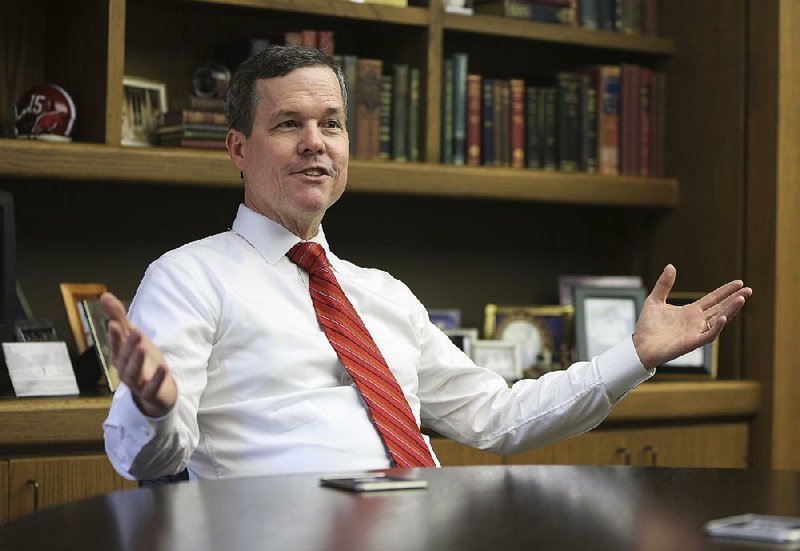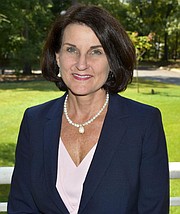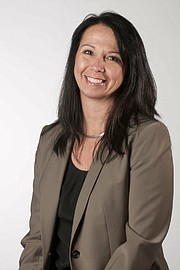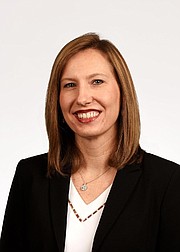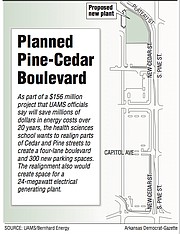A year and a half after dire financial reports led to layoffs at the University of Arkansas for Medical Sciences, the academic medical center is poised to embark on its biggest project in a decade.
If the $156 million project's financing -- proposed through a University of Arkansas System revenue bond issue -- is approved, it will be the first brick-and-mortar expansion of the Little Rock campus since its new hospital opened in 2009, says Christina Clark, UAMS chief operating officer and vice chancellor for institutional support services.
Financing approval is the final step required for much of the project to move forward since UA System trustees endorsed the initiative itself in July. A vote on the financing has not been set.
As outlined in documents, the project is to include:
• A roughly $51 million electricity generator plant near Plateau and Pine streets.
• Revamps of electrical, lighting, mechanical and other infrastructure elements, some of which haven't been updated in decades.
• Hundreds of additional parking spaces.
• The demolition of an unused building contaminated with mold.
Contingent on city of Little Rock approval, the project also would create a four-lane boulevard of Pine and Cedar streets near UAMS, transforming several blocks of what is now Cedar Street into a pedestrian and fire service road.
Overall, the project is designed to knock out $104 million of $667 million in postponed maintenance costs, some of which UAMS officials describe as urgently needed.
According to materials provided to UA System trustees, UAMS officials anticipate $96.2 million in net savings from the project, a figure that factors in utility cost savings; avoided capital costs; debt service payments; and operations, maintenance, measurement and verification costs.
Those calculations include an agreement with Bernhard Energy in which the firm, which will manage the work of the project, guarantees prescribed amounts of annual electric, natural gas and water savings over about two decades.
Any deficits in actual savings are to be paid by the company to UAMS, according to Bernhard officials.
Despite last year's cloud of financial unease at the health sciences center -- at one point in 2018, a projected deficit topped $72 million -- UAMS and UA officials say a subsequent turnaround and associated savings make this "exactly the right time" for such an investment.
If the institution were to take a downturn, "this really is only going to impact that in a positive way. It's going to generate cash for us that we can use for rehabilitating the campus," UAMS Chancellor Cam Patterson said in an interview.
"If we could do a project twice as big and generate twice as much capital for the deferred maintenance that we have, we would do that."
Finances have looked stronger at UAMS lately, as evidenced through the presentation of a balanced budget to the UA System board of trustees for the fiscal year that began July 1 and a move announced in the spring to raise its employees' minimum wage to $14 an hour.
UA System Chief Financial Officer Gina Terry says improved reports from UAMS are in part because of funds that had been reserved for certain purposes but ultimately weren't needed; and one-time payments, such as dollars related to Medicare and Medicaid settlements.
Though many of the pending project's elements have been considered for several years, UAMS administrators say they have talked through the optics of the project and its accompanying expenditure in light of last year's financial problems.
Deteriorating infrastructure is the paramount concern for UAMS officials, Clark said. A sizable share of the project's cost is dedicated to repairing and replacing items that have not seen adequate maintenance in years.
She recalled incidents such as a power failure at a research building that jeopardized years of specimens. (A few emergency generators at UAMS date back to the 1970s, project documents say.)
"The potential of generators failing, the potential of all this critical deferred maintenance that could go wrong -- it's either going to be more expensive to [replace] each thing as they die, or we do it as a big project with energy savings that helps cover it," she said.
Officials also felt that, based on conversations with Bernhard and in-house engineers, the project's energy savings are conservative estimates.
INITIAL HESITATION
Trustees gave the project their unanimous support last month in a special teleconference meeting announced just a few hours in advance of their vote.
After hearing a presentation at a regularly scheduled meeting in March, members of the governing body had balked at the project's price tag, tabling a discussion until they could learn more.
To secure trustees' approval, UAMS officials gave a second presentation at a later meeting and met individually with trustees.
Patterson said the board members offered valuable feedback before signing on in support of the project, and he expects "everyone will get their mind around" its benefits.
"These are complicated deals, and I understand why people would be anxious," he said, but people outside the UA System "are completely aligned with our thinking, which is that there's negligible risk, and tremendous upside."
The project is to be executed under the Arkansas Energy Performance Contracting program, which allows state agencies to engage companies for energy-saving work, such as replacing dated equipment, installing more efficient air conditioning or adding generators.
Under the program, which as of 2013 is overseen by the Arkansas Energy Office, estimated cost savings from energy usage over a maximum 20-year period must be enough to pay for the work and associated financing costs.
According to state energy office emails and correspondence, at least 20 such projects, including many at higher-education institutions, have been overseen by its staff.
But by dollar amount, the large UAMS project would "more than double" the size of active guaranteed energy savings projects in the state, the energy office staff wrote.
Bernhard Energy Chief Operating Officer Tim Staley said he thinks it's one of the largest such projects in the nation at this time.
LENGTHY PROCESS
Preliminary work to set up for the UAMS project has been quietly underway for more than a year, records show.
In June 2018, UAMS officials signed a nonbinding memorandum of understanding to pursue the project under the energy contracting program, according to documents obtained through an Arkansas Freedom of Information Act request.
Last summer, a UAMS committee interviewed four firms to oversee the work, with the energy office acting as an observer.
Bernhard was the committee's unanimous first choice. The firm has been a previous partner on energy efficiency projects at institutions, including the University of Arkansas at Little Rock, and has an established relationship with UAMS.
From September to January, Bernhard conducted a monthslong investment grade audit, which in its final form is a 133-page document detailing the project, floor plans for individual buildings, utilities usage, expected costs and savings.
An investment grade audit is a study of a proposed energy system project that includes detailed descriptions of planned improvements, estimated costs, estimated savings and estimated return on investment.
Reviewing the audit, the state energy office posed more than a dozen questions of Bernhard dealing with technical matters and choice of procedure, such as whether the company and UAMS sought alternatives to tearing out several aging generators on campus.
A nine-page, single-spaced letter from Bernhard addressed concerns in a manner that energy office emails say "sufficiently answered the questions."
"It was clear that Bernhard and UAMS had collectively considered the same concerns we raised regarding cost and applicability of certain [parts of the project], and those considerations are now explained to us," Arkansas Energy Office engineer Tim Quetsch wrote.
"The project managers in this endeavor thus far have been stellar, and I have complete faith that their decisions will deliver a project that benefits the UAMS organization for years to come."
The energy office staff noted in correspondence that the project read more like a capital renewal deferred maintenance project with an attached energy savings guarantee, but that "this is by no means meant in a pejorative context." They also noted that Bernhard had "gone to lengths" to justify the proposal.
A UAMS spokeswoman said in an email that they "are pursuing the deferred maintenance with this project because the energy savings will cover the costs of the deferred maintenance."
Audit documents and summaries presented to trustees show the project comprising 15 "cost reduction measures" dealing with different parts of the campus.
The work includes the installation of energy-usage meters, conversion of lighting to LEDs, upgrades to the essential power system, changes to automatic energy controls, changes to chilled water and heating plants that support heating and air-conditioning systems, and other updates.
The most expensive component is the 24-megawatt generator plant, which is expected to cost around $51 million.
Other big-ticket items include upgrades to the electrical infrastructure for about $18 million; upgrades to automatic energy controls for around $13 million; power system upgrades for $12 million; and the Pine/Cedar realignment, with a price tag of about $12 million.
A smaller 13.5-megawatt generator that's similar to the proposed plant currently provides backup power to the campus' west side, a structure that officials say has essentially paid for itself.
The new plant will allow some east-side buildings at UAMS to take advantage of a special rate from Entergy already being used in other parts of campus called the optional interruptible service tariff.
According to an Entergy spokeswoman, 32 customers in the state are under the tariff, which allows the utility to interrupt power for short periods with advance notice.
Despite expected rate fluctuations for utilities, the plant and many other changes are expected to affect energy usage at UAMS for many years to come.
Project documents say a 2.5% annual rate increase for electricity, a 4% increase for natural gas and a 2% increase for water over two decades were accounted for in calculating the projects' cost savings. Staley said the projected rate increases were calculated via industry guidance and the National Institutes of Standards and Technology handbook, which is used for federal projects.
At the Arkansas Public Service Commission, which regulates electric and natural gas rates charged by providers in the state, Executive Director Donna Gray says it's typical for engineers to make utility rate forecasts.
Outside of the generator plant and proposed changes in the Pine and Cedar area, Clark said much of the project's results won't be visible to UAMS visitors.
"The energy efficiency, that's hard to give you a tangible, to actually feel, touch and see," she said.
PAYING FOR IT
If trustees approve the revenue bond issue to pay for the project, the debt instrument also will undergo a review by the Higher Education Coordinating Board.
Unless trustees call a special meeting -- the circumstances under which they voted to greenlight the project -- the earliest date they would vote is at their annual retreat at the Winthrop Rockefeller Institute on Aug. 20-21.
An agenda for that meeting hasn't been posted.
Bonds taken out by campuses in the UA System are technically in the name of the University of Arkansas board of trustees, Terry says, and take advantage of the System's Aa2 bond rating, which was most recently affirmed in June.
The UAMS project would raise the system's overall debt levels (including bonds, capital leases and other debt) by about 10%, she said.
To date, a campus has never been unable to pay for a bond taken out while it was a member of the UA System.
Financially, Terry said, she thinks UAMS has had "a very good year," adding that chief financial officer and vice chancellor for finance Amanda George is well-versed in health care accounting.
"She has a really good grasp and can really, I think, hold her ground on financial resource usage. So I feel comfortable when she feels that they can, going forward ... control some of the financial areas that were more difficult for them," she said.
George, who was appointed to her role earlier this year, says the bond shouldn't significantly affect UAMS-specific debt levels, because some existing debts are expected to wrap up their repayment schedule within the next few years.
Should the project be completed under budget, any superfluous funds will be redirected to UAMS.
In that case, "I think we would have to have a conversation about what we would do, but I think we would put [those funds] toward more deferred maintenance," George said.
"Unfortunately our budget isn't enough to build in what we need, year over year, to address the immediate, or the long-term, really, deferred maintenance needs ... and so from year to year you're just hitting the top critical things that we have to fix."
"We're working on fixing that."
PINE-CEDAR REDESIGN
Clark says the prospective redesign of Pine and Cedar streets has been on UAMS' wish list for several years and has been discussed with multiple city administrations.
There already is some UAMS lot-parking between the two streets, but the redesign would expand that by 300 spaces and create a boulevard of the two streets at present-day Pine Street.
That change aims to address safety issues related to fast traffic moving on and off Interstate 630, Clark said, which endangers staff members and caused the death of a UAMS resident some years ago.
Mayor Frank Scott Jr.'s spokeswoman, Stephanie Jackson, has said Scott conceptually supports the project, which would require additional city approval on top of the trustees' sign-off.
Through Jackson, city officials declined to comment on the record for this article, not wanting to offer opinions on the project before it's formally introduced.
UAMS administrators say they've discussed several scenarios in which the city might help fund the Pine and Cedar effort, including in the amount of $1 million or $4 million, but no official request has been made.
In the past, Clark said the city's budget constraints have stood in the way of a financial contribution.
On a July afternoon, construction vehicles pushed dirt back and forth in a shady quadrant between Pine and Cedar streets, where more than two dozen houses recently were razed.
The trucks moved between tall trees, most of which will be saved, Clark said.
People who live in the neighborhood say they hadn't heard much yet from UAMS about the development, beyond the demolition of the homes.
Rebecca Sharp, 67, said she wanted to learn more about the project when a reporter summarized its provisions, including the proposed generator plant.
With regard to changes to Pine and Cedar streets, she said "slowing down traffic's a good idea. They do come down that hill [on Pine Street] awful fast."
Mary Allison Sizemore, 26, and Winston Sizemore, 27, agreed, saying they see a wreck in front of their Pine Street house at least once a month.
The two said they were curious to see what would be built in the space once occupied by the demolished houses, which they described as having been in a state of disrepair.
"I'm sure anything will be an improvement over what was there," Winston Sizemore said.
One affect of the tear-down has been on feral cats, thought to have been living around the houses, which the Sizemores now see in the surrounding neighborhood.
At a recent meeting of the Capitol View-Stifft Station Neighborhood Association, a few residents raised a few concerns about flooding, which they feared would be exacerbated by additional parking surfaces at UAMS.
A couple of days after that meeting, representatives from the neighborhood association met with UAMS officials for further discussion.
Association President Hunter Windle said the meeting went well and that the group would remain in dialogue with the medical center's representatives.
"It's going to be a moving target. There's going to be things that kind of come up," he said. "It's a fluid thing. We'll just keep talking."
SundayMonday on 08/04/2019
